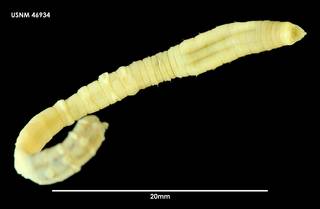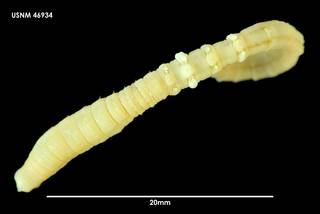BeRMS taxon details
Notomastus latericeus Sars, 1851
129898 (urn:lsid:marinespecies.org:taxname:129898)
accepted
Species
marine, brackish, fresh, terrestrial
recent only
Sars M. (1851). Beretning om i Sommeren 1849 Fortagen Zoologisk Reise i Lofoten og Finmarken. <em>Nyt Magazin Naturvidenskaberne.</em> 6(2):121–211., available online at https://www.biodiversitylibrary.org/page/8152707
page(s): 199-200 [details]
page(s): 199-200 [details]
Read, G.; Fauchald, K. (Ed.) (2024). World Polychaeta Database. Notomastus latericeus Sars, 1851. Accessed through: VLIZ Belgian Marine Species Consortium (2010 onwards) Belgian Register of Marine Species at: https://www.marinespecies.org/berms/aphia.php?p=taxdetails&id=129898 on 2024-04-19
VLIZ Belgian Marine Species Consortium (2010 onwards). Belgian Register of Marine Species. Notomastus latericeus Sars, 1851. Accessed at: https://marinespecies.org/berms/aphia.php?p=taxdetails&id=129898 on 2024-04-19
Date
action
by
![]() The webpage text is licensed under a Creative Commons Attribution 4.0 License
The webpage text is licensed under a Creative Commons Attribution 4.0 License
original description
Sars M. (1851). Beretning om i Sommeren 1849 Fortagen Zoologisk Reise i Lofoten og Finmarken. <em>Nyt Magazin Naturvidenskaberne.</em> 6(2):121–211., available online at https://www.biodiversitylibrary.org/page/8152707
page(s): 199-200 [details]
context source (Deepsea) Budaeva N.E., Jirkov I.A., Savilova T.A., Paterson G.L.J. (2014). Deep-sea fauna of European seas: An annotated species check-list of benthic invertebrates living deeper than 2000 m in the seas bordering Europe. Polychaeta. <i>Invertebrate Zoology</i>. Vol.11. No.1: 217–230 [in English]. [details] Available for editors
context source (HKRMS) BU. (2013). Provision of services for field sampling, species identification and data analysis of benthic faunal communities of Hong Kong marin waters. Final report submitted to EPD. [details]
context source (Schelde) Maris, T.; Beauchard, O.; Van Damme, S.; Van den Bergh, E.; Wijnhoven, S.; Meire, P. (2013). Referentiematrices en Ecotoopoppervlaktes Annex bij de Evaluatiemethodiek Schelde-estuarium Studie naar “Ecotoopoppervlaktes en intactness index”. <em>Monitor Taskforce Publication Series, 2013-01. NIOZ: Yerseke.</em> 35 pp. (look up in IMIS) [details]
context source (BeRMS 2020) Bio-environmental research group; Institute of Agricultural and Fisheries research (ILVO), Belgium; (2015): Macrobenthos monitoring in function of the Water Framework Directive in the period 2007-2009. [details]
context source (Bermuda) Sterrer, W. (1986). Marine fauna and flora of Bermuda: a systematic guide to the identification of marine organisms. <em>Wiley-Interscience Publication. Wiley.</em> 742 pp (Nemertini part). [details] Available for editors
basis of record Bellan, G. (2001). Polychaeta, <i>in</i>: Costello, M.J. <i>et al.</i> (Ed.) (2001). European register of marine species: a check-list of the marine species in Europe and a bibliography of guides to their identification. <em>Collection Patrimoines Naturels.</em> 50: 214-231. (look up in IMIS) [details]
additional source Brunel, P., L. Bosse & G. Lamarche. (1998). Catalogue of the marine invertebrates of the estuary and Gulf of St. Lawrence. <em>Canadian Special Publication of Fisheries and Aquatic Sciences, 126.</em> 405 pp. (look up in IMIS) [details] Available for editors
additional source Day, J. H. (1967). [Sedentaria] A monograph on the Polychaeta of Southern Africa. Part 2. Sedentaria. British Museum (Natural History), London. pp. 459–842., available online at http://www.biodiversitylibrary.org/bibliography/8596 [details]
additional source Muller, Y. (2004). Faune et flore du littoral du Nord, du Pas-de-Calais et de la Belgique: inventaire. [Coastal fauna and flora of the Nord, Pas-de-Calais and Belgium: inventory]. <em>Commission Régionale de Biologie Région Nord Pas-de-Calais: France.</em> 307 pp., available online at http://www.vliz.be/imisdocs/publications/145561.pdf [details]
additional source Chamberlin, Ralph V. (1919). The Annelida Polychaeta [Albatross Expeditions]. <em>Memoirs of the Museum of Comparative Zoology at Harvard College.</em> 48: 1-514., available online at http://www.biodiversitylibrary.org/ia/memoirsofmuseumo4801harv [details]
additional source Fauvel, P. 1907. Première note préliminaire sur les Polychètes provenant des campagnes de l'Hirondelle et de la Princesse-Alice ou déposées dans le Musée Océanographique de Monaco. Bulletin de l'Institute océanographique, 107: 1-34. [details]
additional source Fauvel, Pierre. (1909). Deuxième note préliminaire sur les polychètes provenant des campagnes de l'<i>Hirondelle</i> et de la <i>Princesse-Alice</i>, ou déposées dans la Musée Océanographique de Monaco. <em>Bulletin de l'Institute Océanographique de Monaco.</em> 142: 1-76., available online at http://biodiversitylibrary.org/page/46491917 [details]
additional source Fauvel, P. (1926). Sur les capitelliens. <em>Bulletin de la Société Zoologique de France.</em> 51: 296-301., available online at http://gallica.bnf.fr/ark:/12148/bpt6k5445912x/f307.item [details]
additional source Sars, M. (1856). Nye Annelider. <em>Fauna littoralis Norvegiae (Fredrik D. Beyer. Bergen).</em> heft 2:1-24., available online at http://biodiversitylibrary.org/page/41477013
page(s): 9-13, plate II figs. 8-17 [details]
additional source Thomassin, B.A. (1970). Contribution à l'étude des polychètes de la région de Tuléar (S.W. de Madagascar). III. Sur les Capitellidae des sables coralliens. <em>Recueil des Travaux de la Station Marine d'Endoume.</em> 10: 71-101.
page(s): 83-86, fig. 8 [details] Available for editors
additional source Fauchald, K.; Granados-Barba, A.; Solís-Weiss, V. (2009). Polychaeta (Annelida) of the Gulf of Mexico, Pp. 751–788 in D.L. Felder and D.K. Camp (eds.). <em>Gulf of Mexico. Origin, Waters, and Biota. Volume 1, Biodiversity.</em> Texas A&M University Press, College Station, Texas., available online at https://books.google.es/books?id=CphA8hiwaFIC&lpg=PR1&pg=PA751 [details]
additional source Liu, J.Y. [Ruiyu] (ed.). (2008). Checklist of marine biota of China seas. <em>China Science Press.</em> 1267 pp. (look up in IMIS) [details] Available for editors
additional source Trott, T. J. (2004). Cobscook Bay inventory: a historical checklist of marine invertebrates spanning 162 years. <em>Northeastern Naturalist.</em> 11, 261-324., available online at http://www.gulfofmaine.org/kb/files/9793/TROTT-Cobscook%20List.pdf [details] Available for editors
additional source Fauchald, K. (1977). The polychaete worms, definitions and keys to the orders, families and genera. <em>Natural History Museum of Los Angeles County: Los Angeles, CA (USA), Science Series.</em> 28:1-188., available online at http://www.vliz.be/imisdocs/publications/123110.pdf [details]
additional source Integrated Taxonomic Information System (ITIS). , available online at http://www.itis.gov [details]
page(s): 199-200 [details]
context source (Deepsea) Budaeva N.E., Jirkov I.A., Savilova T.A., Paterson G.L.J. (2014). Deep-sea fauna of European seas: An annotated species check-list of benthic invertebrates living deeper than 2000 m in the seas bordering Europe. Polychaeta. <i>Invertebrate Zoology</i>. Vol.11. No.1: 217–230 [in English]. [details] Available for editors
context source (HKRMS) BU. (2013). Provision of services for field sampling, species identification and data analysis of benthic faunal communities of Hong Kong marin waters. Final report submitted to EPD. [details]
context source (Schelde) Maris, T.; Beauchard, O.; Van Damme, S.; Van den Bergh, E.; Wijnhoven, S.; Meire, P. (2013). Referentiematrices en Ecotoopoppervlaktes Annex bij de Evaluatiemethodiek Schelde-estuarium Studie naar “Ecotoopoppervlaktes en intactness index”. <em>Monitor Taskforce Publication Series, 2013-01. NIOZ: Yerseke.</em> 35 pp. (look up in IMIS) [details]
context source (BeRMS 2020) Bio-environmental research group; Institute of Agricultural and Fisheries research (ILVO), Belgium; (2015): Macrobenthos monitoring in function of the Water Framework Directive in the period 2007-2009. [details]
context source (Bermuda) Sterrer, W. (1986). Marine fauna and flora of Bermuda: a systematic guide to the identification of marine organisms. <em>Wiley-Interscience Publication. Wiley.</em> 742 pp (Nemertini part). [details] Available for editors
basis of record Bellan, G. (2001). Polychaeta, <i>in</i>: Costello, M.J. <i>et al.</i> (Ed.) (2001). European register of marine species: a check-list of the marine species in Europe and a bibliography of guides to their identification. <em>Collection Patrimoines Naturels.</em> 50: 214-231. (look up in IMIS) [details]
additional source Brunel, P., L. Bosse & G. Lamarche. (1998). Catalogue of the marine invertebrates of the estuary and Gulf of St. Lawrence. <em>Canadian Special Publication of Fisheries and Aquatic Sciences, 126.</em> 405 pp. (look up in IMIS) [details] Available for editors
additional source Day, J. H. (1967). [Sedentaria] A monograph on the Polychaeta of Southern Africa. Part 2. Sedentaria. British Museum (Natural History), London. pp. 459–842., available online at http://www.biodiversitylibrary.org/bibliography/8596 [details]
additional source Muller, Y. (2004). Faune et flore du littoral du Nord, du Pas-de-Calais et de la Belgique: inventaire. [Coastal fauna and flora of the Nord, Pas-de-Calais and Belgium: inventory]. <em>Commission Régionale de Biologie Région Nord Pas-de-Calais: France.</em> 307 pp., available online at http://www.vliz.be/imisdocs/publications/145561.pdf [details]
additional source Chamberlin, Ralph V. (1919). The Annelida Polychaeta [Albatross Expeditions]. <em>Memoirs of the Museum of Comparative Zoology at Harvard College.</em> 48: 1-514., available online at http://www.biodiversitylibrary.org/ia/memoirsofmuseumo4801harv [details]
additional source Fauvel, P. 1907. Première note préliminaire sur les Polychètes provenant des campagnes de l'Hirondelle et de la Princesse-Alice ou déposées dans le Musée Océanographique de Monaco. Bulletin de l'Institute océanographique, 107: 1-34. [details]
additional source Fauvel, Pierre. (1909). Deuxième note préliminaire sur les polychètes provenant des campagnes de l'<i>Hirondelle</i> et de la <i>Princesse-Alice</i>, ou déposées dans la Musée Océanographique de Monaco. <em>Bulletin de l'Institute Océanographique de Monaco.</em> 142: 1-76., available online at http://biodiversitylibrary.org/page/46491917 [details]
additional source Fauvel, P. (1926). Sur les capitelliens. <em>Bulletin de la Société Zoologique de France.</em> 51: 296-301., available online at http://gallica.bnf.fr/ark:/12148/bpt6k5445912x/f307.item [details]
additional source Sars, M. (1856). Nye Annelider. <em>Fauna littoralis Norvegiae (Fredrik D. Beyer. Bergen).</em> heft 2:1-24., available online at http://biodiversitylibrary.org/page/41477013
page(s): 9-13, plate II figs. 8-17 [details]
additional source Thomassin, B.A. (1970). Contribution à l'étude des polychètes de la région de Tuléar (S.W. de Madagascar). III. Sur les Capitellidae des sables coralliens. <em>Recueil des Travaux de la Station Marine d'Endoume.</em> 10: 71-101.
page(s): 83-86, fig. 8 [details] Available for editors
additional source Fauchald, K.; Granados-Barba, A.; Solís-Weiss, V. (2009). Polychaeta (Annelida) of the Gulf of Mexico, Pp. 751–788 in D.L. Felder and D.K. Camp (eds.). <em>Gulf of Mexico. Origin, Waters, and Biota. Volume 1, Biodiversity.</em> Texas A&M University Press, College Station, Texas., available online at https://books.google.es/books?id=CphA8hiwaFIC&lpg=PR1&pg=PA751 [details]
additional source Liu, J.Y. [Ruiyu] (ed.). (2008). Checklist of marine biota of China seas. <em>China Science Press.</em> 1267 pp. (look up in IMIS) [details] Available for editors
additional source Trott, T. J. (2004). Cobscook Bay inventory: a historical checklist of marine invertebrates spanning 162 years. <em>Northeastern Naturalist.</em> 11, 261-324., available online at http://www.gulfofmaine.org/kb/files/9793/TROTT-Cobscook%20List.pdf [details] Available for editors
additional source Fauchald, K. (1977). The polychaete worms, definitions and keys to the orders, families and genera. <em>Natural History Museum of Los Angeles County: Los Angeles, CA (USA), Science Series.</em> 28:1-188., available online at http://www.vliz.be/imisdocs/publications/123110.pdf [details]
additional source Integrated Taxonomic Information System (ITIS). , available online at http://www.itis.gov [details]
 Present
Present  Inaccurate
Inaccurate  Introduced: alien
Introduced: alien  Containing type locality
Containing type locality
Unknown type, geounit Norway [details]
| Language | Name | |
|---|---|---|
| Japanese | シダレイトゴカイ | [details] |
Marine Life Information Network - UK
To Barcode of Life (13 barcodes)
To Biodiversity Heritage Library (76 publications)
To Biological Information System for Marine Life (BISMaL)
To European Nucleotide Archive (ENA)
To GenBank (13 nucleotides; 6 proteins)
To Global Biotic Interactions (GloBI)
To NMNH Extant Collection (Notomastus latericeus (1) 46934)
To PESI
To The Arctic Traits Database (28 traits)
To USNM Invertebrate Zoology Annelida Collection (2012 records)
To ITIS
To Barcode of Life (13 barcodes)
To Biodiversity Heritage Library (76 publications)
To Biological Information System for Marine Life (BISMaL)
To European Nucleotide Archive (ENA)
To GenBank (13 nucleotides; 6 proteins)
To Global Biotic Interactions (GloBI)
To NMNH Extant Collection (Notomastus latericeus (1) 46934)
To PESI
To The Arctic Traits Database (28 traits)
To USNM Invertebrate Zoology Annelida Collection (2012 records)
To ITIS



